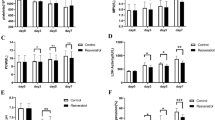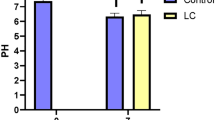Abstract
The aim of this study is to investigate the effects of a nitric oxide (NO) donor S-nitrosoglutathione (GSNO) on the metabolism and improvement of preservation quality in apheresis platelets. A GSNO solution with a certain concentration was added into fresh apheresis platelets, and the parameters associated with platelet morphology, metabolism and function were temporally monitored for 7 days. The results showed that the NO level in GSNO group were remarkably higher than those in the control group during the whole storage stage. No significant morphology or function difference was observed between the control and GSNO groups such as Platelet count, platelet distribution width, mean platelet volume and mitochondrial metabolic activity. But in metabolism there are something differences from morphology data: pCO2, pO2, cHCO3 − were also found to have no clear difference between the control and GSNO groups; the lactic acid content, sugar consumption and Lactate dehydrogenase activity in the GSNO group were lower than that in the control group at some time point; and pH values in the GSNO group were higher than the control group. Our study discovered that the NO donor GSNO can reduce the metabolism and maintain the cellular characteristics of platelets in vitro during the platelet storage period.


Similar content being viewed by others
References
Devine DV, Serrano K (2010) The platelet storage lesion. Clin Lab Med 30(2):475–487
Thon JN, Schubert P, Devine DV (2008) Platelet storage lesion: a new understanding from a proteomic perspective. Transfus Med Rev 22(4):268–279
Shrivastava M (2009) The platelet storage lesion. Transfus Apher Sci 41(2):105–113
Zhang JG, Carter CJ, Culibrk B, Devine DV, Levin E, Scammell K, Weiss S, Gyongyossy-Issa MI (2008) Buffy-coat platelet variables and metabolism during storage in additive solutions or plasma. Transfusion 48(5):847–856
Li J, Xia Y, Bertino AM, Coburn JP, Kuter DJ (2000) The mechanism of apoptosis in human platelets during storage. Transfusion 40(11):1320–1329
Solheim BG, Flesland O, Seghatchian J, Brosstad F (2004) Clinical implications of red blood cell and platelet storage lesions: an overview. Transfus Apher Sci 31(3):185–189
Tulika C, Ashish G, Ashutosh K, Sheeba A (2011) Morphological and functional changes in random donor platelets stored for seven days in platelet additive solution. Int J Blood Transfus Immunohematol 1:20
van der Meer PF, de Korte D (2011) Platelet preservation: agitation and containers. Transfus Apher Sci 44(3):297–304
Sandgren P, Saeed K (2011) Storage of buffy-coat-derived platelets in additive solution: in vitro effects on platelets of the air bubbles and foam included in the final unit. Blood Transfus 9(2):182–188
Schubert P, Devine DV (2010) Towards targeting platelet storage lesion-related signaling pathways. Blood Transfus 8(Suppl 3):s69–s72
Dumont LJ, AuBuchon JP, Gulliksson H, Slichter SJ, Elfath MD, Holme S, Murphy JR, Rose LE, Popovsky MA, Murphy S (2006) In vitro pH effects on in vivo recovery and survival of platelets: an analysis by the BEST collaborative. Transfusion 46(8):1300–1305
Shapira S, Friedman Z, Shapiro H, Presseizen K, Radnay J, Ellis MH (2000) The effect of storage on the expression of platelet membrane phosphatidylserine and the subsequent impacton the coagulant function of stored platelets. Transfusion 40(10):1257–1263
Seghatchian J, Krailadsiri P (2001) Platelet storage lesion and apoptosis: are they related? Transfus Apher Sci 24(1):103–105
Wood EM, Colton E, Yomtovian RA, Currie LM, Connor J, Anderson JM (2000) Prevention of monocyte adhesion and inflammatory cytokine production during blood platelet storage: an in vitro model with implications for transfusion practice. J Biomed Mater Res 51(2):147–154
Radomski MW, Zakar T, Salas E (1996) Nitric oxide in platelets. Methods Enzymol 269:88–107
Sener A, Egemen G, Cevik O, Yanikkaya-Demirel G, Apikoglu-Rabus S, Ozsavci D (2013) In vitro effects of nitric oxide donors on apoptosis and oxidative/nitrative protein modifications in ADP-activated platelets. Hum Exp Toxicol 32(3):225–235
Riss TL, Moravec RA (1992) Comparison of MTT, XTT, and a novel tetrazolium compound MTS for in vitro proliferation and chemosensitivity assays. Mol Biol Cell 3:184–194
Xiong J, Zhu J, Dai W, Dong C, Qiu Q, Li C (2017) Integrating gut microbiota immaturity and disease-discriminatory taxa to diagnose the initiation and severity of shrimp disease. Environ Microbiol 19(4):1490–1501
Dai W, Zhang J, Tu Q, Deng Y, Qiu Q, Xiong J (2017) Bacterioplankton assembly and interspecies interaction indicating increasing coastal eutrophication. Chemosphere 177:317–325
Xiong J, Zhu J, Wang K, Wang X, Ye X, Liu L, Zhao Q, Hou M, Qiuqian L, Zhang D (2014) The temporal scaling of bacterioplankton composition: high turnover and predictability during shrimp cultivation. Microb Ecol 67(2):256–264
Cesar J, DiMinno G, Alam I, Silver M, Murphy S (1987) Plasma free fatty acid metabolism during storage of platelet concentrates for transfusion. Transfusion 27(5):434–437
Gulliksson H (2003) Defining the optimal storage conditions for the long-term storage of platelets. Transfus Med Rev 17(3):209–215
Gkaliagkousi E, Ritter J, Ferro A (2007) Platelet-derived nitric oxide signaling and regulation. Circ Res 101(7):654–662
Marjanovic JA, Stojanovic A, Brovkovych VM, Skidgel RA, Du X (2008) Signaling-mediated functional activation of inducible nitric-oxide synthase and its role in stimulating platelet activation. J Biol Chem 283(43):28827–28834
Oberprieler NG, Roberts W, Riba R, Graham AM, Homer-Vanniasinkam S, Naseem KM (2007) cGMP-independent inhibition of integrin alphaIIbbeta3-mediated platelet adhesion and outside-in signalling by nitric oxide. FEBS Lett 581(7):1529–1534
Shiri R, Yari F, Ahmadinejad M, Vaeli S, Tabatabaei MR (2014) The caspase-3 inhibitor (peptide Z-DEVD-FMK) affects the survival and function of platelets in platelet concentrate during storage. Blood research 49(1):49–53
Picker SM, Schneider V, Oustianskaia L, Gathof BS (2009) Cell viability during platelet storage in correlation to cellular metabolism after different pathogen reduction technologies. Transfusion 49(11):2311–2318
Tynngard N, Wallstedt M, Sodergren AL, Faxalv L, Ramstrom S (2015) Platelet adhesion changes during storage studied with a novel method using flow cytometry and protein-coated beads. Platelets 26(2):177–185
Deyhim MR, Mesbah-Namin SA, Yari F, Taghikhani M, Amirizadeh N (2015) L-carnitine effectively improves the metabolism and quality of platelet concentrates during storage. Ann Hematol 94(4):671–680
Tynngard N (2009) Preparation, storage and quality control of platelet concentrates. Transfus Apher Sci 41(2):97–104
Crane MS, Ollosson R, Moore KP, Rossi AG, Megson IL (2002) Novel role for low molecular weight plasma thiols in nitric oxide-mediated control of platelet function. J Biol Chem 277(49):46858–46863
Skrzypchak AM, Lafayette NG, Bartlett RH, Zhou Z, Frost MC, Meyerhoff ME, Reynolds MM, Annich GM (2007) Effect of varying nitric oxide release to prevent platelet consumption and preserve platelet function in an in vivo model of extracorporeal circulation. Perfusion 22(3):193–200
Wu T, Zhang C, Wang Z, Liu J, Li H, Zhou W, Wang S (2013) Inhibitory role of S-nitrosoglutathione in the aggregation of frozen platelets, and its effect on the expression of membrane glycoproteins. Exp Ther Med 6(3):831–839
Lee JH, Kim JT, Cho YG (2008) Effect of nitric oxide on the cryopreservation of platelets. Korean J Lab Med 28(2):136–143
Wong K, Li X (2004) Nitric oxide infusion alleviates cellular activation during preparation, leukofiltration and storage of platelets. Transfus Apher Sci 30(1):29–39
Acknowledgements
We thank Yan Wang and Huihui Feng for contribution to serve the blood donors and PCs collection. This work was supported by the Grants from the Project of Science and Technology Department of Ningbo (No. 2017C50046) and Project of Health Department of Ningbo (No. 2016A17).
Author information
Authors and Affiliations
Contributions
Author’s Contributions
QL and GD conceived and designed the experiments; LY, SY, YH and GD performed the experiments and evaluated the results; QL, QL, DX and KH contributed reagents and materials; GD, LY and SY wrote the manuscript.
Corresponding author
Ethics declarations
Conflict of interest
None of the authors have any conflict of interest to declare.
Rights and permissions
About this article
Cite this article
Yu, L., Yu, S., He, Y. et al. Effect of Nitric Oxide Donor on Metabolism of Apheresis Platelets. Indian J Hematol Blood Transfus 34, 517–523 (2018). https://doi.org/10.1007/s12288-017-0881-1
Received:
Accepted:
Published:
Issue Date:
DOI: https://doi.org/10.1007/s12288-017-0881-1




